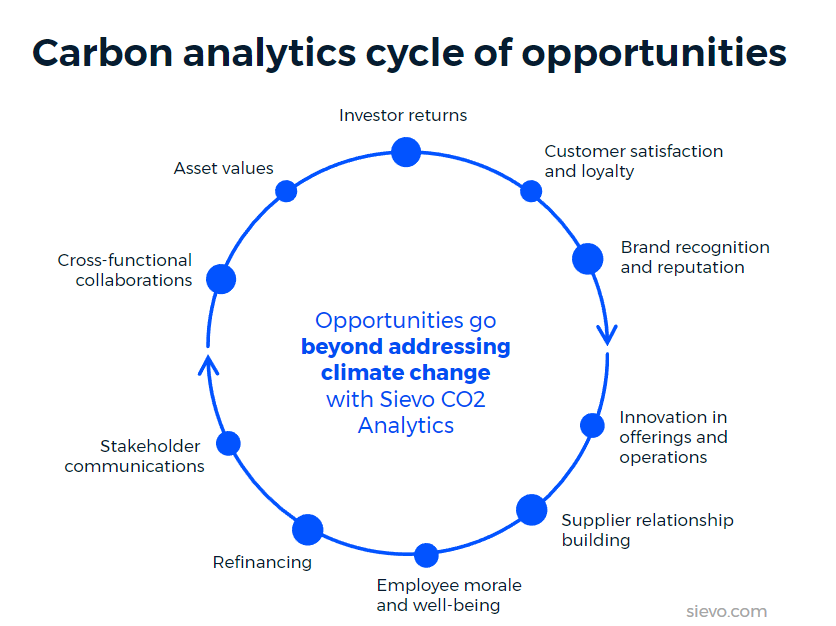The time to act on reducing emissions is now. As businesses face increasing pressure to reduce their carbon footprint and contribute to a more sustainable future, the key steps are understanding and addressing their emissions.
This is where carbon analytics comes in - using software tools and data analysis to measure and act on a company's carbon footprint, set emissions reduction targets, identify areas for improvement, and track how emissions develop over time.
What is Carbon Analytics and Why is it Important?
Carbon analytics uses data and software tools to manage a company's carbon footprint. It is an essential component of corporate sustainability strategies, as it enables businesses to understand their impact on the environment, identify opportunities to reduce emissions, and act upon them.
Using Carbon Analytics to Achieve Your ESG and Sustainability Goals
Carbon analytics is critical in helping companies achieve their ESG and sustainability goals. By measuring their carbon footprint and identifying carbon hotspots, companies can set emissions reduction targets, begin reduction projects, track progress towards those targets, and communicate their sustainability performance to the stakeholders.
Here are the necessary steps for achieving your Greenhouse Gas (GHG) reduction targets with carbon analytics:
Understanding Your Carbon Footprint with Carbon Tracking
Carbon measurement and tracking are the foundation of carbon analytics. Companies must first understand their carbon footprint before taking steps to reduce it. A carbon footprint is the total amount of greenhouse gas emissions produced directly or indirectly by an organization or an individual.
Carbon tracking involves gathering data on a company's greenhouse gas (GHG) emissions, including direct emissions (Scope 1), indirect emissions from purchased electricity, heat, and steam (Scope 2), and indirect emissions from the value chain (Scope 3).
Read more on how to tackle Scope 3 emissions
Identifying Carbon Hotspots for Effective Emissions Reduction
Carbon hotspots are areas of a company's operations where emissions are exceptionally high or difficult to reduce. Identifying these hotspots is vital for effective carbon reduction strategies. Carbon analytics solutions can help companies identify their hotspots and prioritize actions to reduce emissions in these areas.
Here's how to reduce emissions in practice - watch the video!
Setting Science-Based Targets for Emissions Reduction
Once companies have measured their carbon footprint, they can set GHG reduction targets to begin their journey to a decarbonized future—many associating targets as those in line with science.
For example, as of the beginning of March 2023, 2342 companies have set targets, and 4632 companies are taking action based on the guidance of the Science Based Targets initiative (SBTi). SBTi’:s are designed to help companies reduce their emissions in line with the Paris Agreement's goal of limiting global warming to below 2 degrees Celsius.
Tracking Progress against science-based targets
Carbon analytics also enables companies to track progress toward emissions reduction targets. This is important because it allows companies to identify areas where they are not making enough progress and take corrective action.
Learn more on how to measure sustainable performance
Demonstrating Commitment to Sustainability and ESG Goals
Finally, companies can use carbon analytics to communicate their sustainability performance to stakeholders. By reporting on their carbon emissions and progress toward their emissions reduction targets, companies can demonstrate their commitment to sustainability and ESG goals to their investors, customers, and other stakeholders.
Not familiar with the ESG framework? Here's ESG explained
Carbon Software Solutions
Carbon analytics software solutions, like Sievo CO2 Analytics, enable companies to streamline the carbon tracking and measurement process, generate reports and visualizations, analyze data to identify improvement areas, and start reduction initiatives.
Carbon software solutions include:
- Carbon accounting software - enables companies to calculate their carbon footprint and generate reports for internal and external stakeholders.
- ESG reporting software - helps companies report on their environmental, social, and governance (ESG) performance, including carbon emissions.
- Supply chain sustainability software enables companies to assess their suppliers' sustainability performance and identify improvement opportunities.
How Our CO2 Analytics Solution Can Help You Achieve Your Goals
Carbon analytics is critical to corporate sustainability strategies, enabling companies to measure, track, and reduce their carbon footprint.
Sievo CO2 Analytics is an easy yet comprehensive solution to manage your company's emissions as well as gain opportunities that go beyond addressing climate change.

Our customers can measure their carbon footprint with complete control over the level of granularity and take action by identifying hotspots, starting emission reduction initiatives, and increasing supplier engagement by gathering more information about their sustainability performance.
With our verified solution, you will gain emission insights, can also track your progress and communicate your sustainability performance to stakeholders – while growing together with sustainable suppliers and customers.
Want to hear more about out CO2 verification methodology? Visit the trust center.
Contact our team to learn more about how our CO2 analytics software solutions can help your business reduce its carbon footprint!




